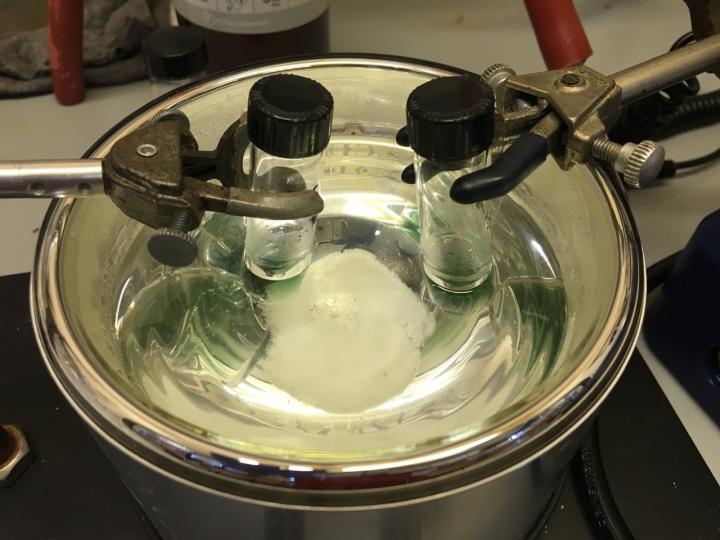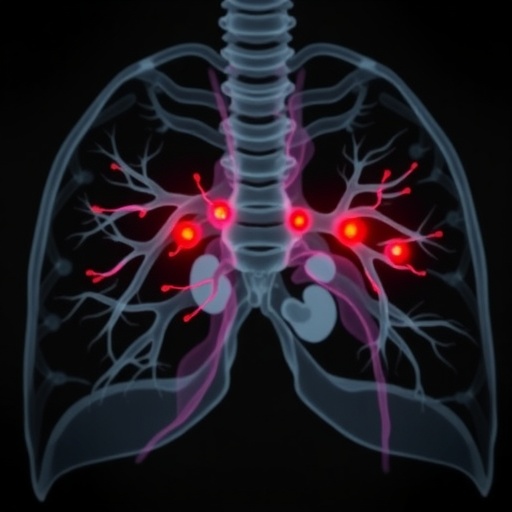
Credit: SMU
A new catalyst for breaking the tough molecular bond between carbon and hydrogen holds the promise of a cleaner, easier and cheaper way to derive products from petroleum, says a researcher at Southern Methodist University, Dallas.
"Some of the most useful building blocks we have in the world are simple, plentiful hydrocarbons like methane, which we extract from the ground. They can be used as starting materials for complex chemical products such as plastics and pharmaceuticals," said Isaac Garcia-Bosch, Harold A. Jeskey Endowed Chair assistant professor in the Department of Chemistry at SMU. "But the first step of the process is very, very difficult — breaking that carbon-hydrogen bond. The stronger the bond, the more difficult it is to oxidize."
The chemical industry must break the tenacious bond between carbon and hydrogen molecules to synthesize oxidative products such as methanol and phenols. It's called oxidizing because it causes the molecule to undergo a reaction in which it combines with oxygen, breaking C-H bonds and forming new carbon-oxygen bonds.
The conventional chemical recipe calls for inefficient and expensive oxidants to break the C-H bond. That process is costly, difficult and leaves behind dirty waste products.
Chemists at SMU, in collaboration with The Johns Hopkins University, have found a cheaper, cleaner way to crack the stubborn C-H bond.
Garcia-Bosch and chemist Maxime A. Siegler, director of the X-ray Crystallography Facility at The Johns Hopkins University, used copper catalysts that in combination with hydrogen peroxide (oxygen source) can convert C-H bonds to C-O bonds.
"This is a very important discovery because it's the first time it's been proven that copper can carry out this kind of oxidation outside of nature in an efficient way," Garcia-Bosch said. "The prep is very simple, so labs anywhere can do it. Copper is relatively cheap compared to other metals such as palladium, gold or silver, and hydrogen peroxide is readily available, relatively cheap and very clean. One of the byproducts of oxidations with hydrogen peroxide (H2O2) is water (H2O), which is the cleanest waste product you could have."
Additionally, the researchers found the right ligand — a nitrogen-based material that binds to the copper so that the oxidation process can occur with close to perfect efficiency.
It's important to have the right ligand, the right amount of hydrogen peroxide, and the right metal in order to oxidize these challenging C-H bonds.
"We found that combination," Garcia-Bosch said.
Chemistry is like a puzzle, where you build new molecules out of other molecules, he said.
In any one molecule there are many C-H bonds. For example in octanes, such as the ones found in gasoline, there's a carbon chain of eight carbons with multiple C-H bonds with different chemical properties, Garcia-Bosch said, and from the oxidation of each of the C-H bonds, a different product results.
Chemists design catalysts that are capable of breaking and forming bonds in order to build complex chemical structures.
"Catalysts have to be able to select between different C-H bonds and form new carbon-oxygen, carbon-nitrogen or carbon-fluoride bonds, for example," Garcia-Bosch said. "Biological processes use metals to do this all the time, for example in our bodies when our liver processes a pharmaceutical that we ingest using iron. Minerals such as iron, copper, manganese, calcium and potassium are critical for the natural catalytic process. For example, trees use manganese (photosynthesis) to transform water into the oxygen that we breathe"
Garcia-Bosch and Siegler reported their findings in the article "Copper-Catalyzed Oxidation of Alkanes with H2O2 under a Fenton-like Regime," published in the international edition of the journal Angewandte Chemie.
First time for using copper for C-H oxidation
In organic chemistry, there aren't many examples of copper as a catalyst for carbon-hydrogen oxidation. Most examples are based on iron.
"This is the first time in our field that we've used copper to do this C-H oxidation in a very efficient way," Garcia-Bosch said.
"Copper is very versatile in nature," he said. "With small changes in the environment of copper, you can do very diverse chemistry. That's why we picked it."
That environment is the ligand, which gives properties to the copper to spark the chemical reaction when the chemical ingredients are combined in a vial or round bottom flask.
The researchers discovered that these catalysts — copper in the form of a white salt and the ligand as an oil — can oxidize C-H bonds in a very efficient way in combination with hydrogen peroxide, a reduced form of oxygen that nature uses.
"You can find hydrogen peroxide anywhere, even at home in your medicine cabinet. So it's a mild oxidant," Garcia-Bosch said. "It's convenient also, because it's a liquid, rather than, say, a gas, which might require special storage. You mix everything together in a solvent and it reacts. It's like making a soup, a recipe, then you analyze the result to see what you get."
Using a gas chromatography instrument, the Garcia-Bosch and Siegler analyzed the final solution to observe the results of the reaction. That allowed them to quantify the amount of oxidation product that was formed during the reaction.
Next step — targeting a specific C-H bond
"We tested this catalytic system for different substrates and we saw that it's not very selective," Garcia-Bosch said. "That's a problem. So if we have molecules that have many different C-H bonds, then it's going to oxidize all of them in a non-selective manner. In our lab, we would like to find selective catalysts. That's the next project."
###
Media Contact
Margaret Allen
[email protected]
214-768-7664
@smu
http://www.smu.edu
############
Story Source: Materials provided by Scienmag





